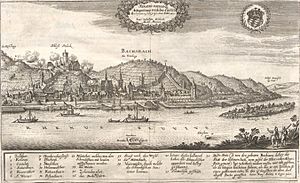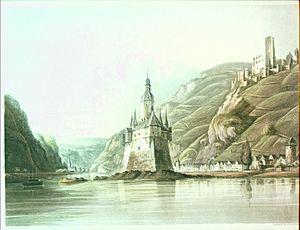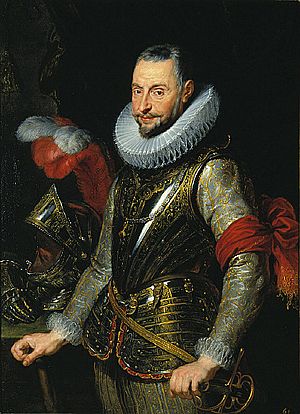Capture of Bacharach facts for kids
Quick facts for kids Capture of Bacharach |
|||||||
|---|---|---|---|---|---|---|---|
| Part of the Palatinate phase of the Thirty Years' War | |||||||
 View of Bacharach by Matthäus Merian |
|||||||
|
|||||||
| Belligerents | |||||||
| Commanders and leaders | |||||||
| Strength | |||||||
| 2,500–5,000 | |||||||
| Casualties and losses | |||||||
| 3 dead and 3 wounded | |||||||
The Capture of Bacharach was an important event during the Thirty Years' War. It happened on October 1, 1620, in a town called Bacharach in Germany. This conflict was part of the Palatinate campaign. Spanish forces, led by Don Gonzalo Fernández de Córdoba, fought against Protestant forces. The Protestant forces were loyal to Frederick V, Elector Palatine. Frederick V was also known as the "Winter King" of Bohemia.
The Spanish invasion of Frederick V's lands started quickly. But it slowed down in mid-September after the Capture of Oppenheim. Don Ambrosio Spinola was the main Spanish general. He had to choose between attacking Heidelberg or Bacharach. Spanish officers decided to take Bacharach. They knew Frederick's forces there were small and spread out. On October 1, Córdoba captured Bacharach with 2,500 soldiers. The Anglo-German defenders had to give up.
Why Bacharach Was Important
After taking Oppenheim, the Spanish army had enough food and supplies. General Spinola then had a big decision to make. He could attack either Heidelberg or Bacharach. On September 23, Spinola met with his top commanders. They talked about marching on Heidelberg, Frankenthal, or Bacharach. In the end, Spinola chose Bacharach.
Bacharach was a very important place for a few reasons. It was a bridgehead over the Rhine river. This meant it could connect Spanish-controlled areas of the Palatinate with the city of Mainz. Taking Bacharach would also give the Spanish army time. They were waiting for more soldiers to arrive from the Spanish Netherlands.
On September 27, Spinola got news. About 5,000 soldiers from the United Provinces were coming. These soldiers were led by Henry of Nassau-Dillenburg and Sir Horace Vere. They had crossed the Moselle river to help Frederick V.
Spinola didn't know exactly how many soldiers Vere had. These forces included Dutch, English, and Scottish volunteers. They were sent by King James I of England. Spinola decided to move his army to the west side of the Rhine. He wanted to wait for the Protestant forces there. Spinola focused on stopping the Anglo-Dutch relief. He left the job of capturing Bacharach to Don Gonzalo Fernández de Córdoba.
The Battle for Bacharach
On September 29, Córdoba marched his soldiers and captured Lorch. The few defenders there quickly surrendered. He also sent another group of about 2,000 men directly to Bacharach. This group reached the edge of Bacharach around 2 AM. When the Spanish arrived, the Protestant soldiers outside the town dropped their weapons. They ran inside the town for safety. Córdoba's men then started building a defensive wall behind the town.
At dawn, the defenders in Bacharach began firing. A heavy mist helped them hide. They killed three Spanish soldiers and wounded three more. Soon after, the main Spanish forces led by Córdoba arrived. The defenders felt hopeless when they saw how many Spanish soldiers there were. The officers of the Bacharach garrison decided to surrender. Spanish troops entered Bacharach at 3 PM. Two captains and 94 English soldiers were taken prisoner. Many German troops were also captured.
What Happened Next
After taking Bacharach, Córdoba left 300 soldiers to guard the town. He sent most of his other troops to capture Kaub. These troops were led by commanders Diego Ruiz and Baltasar de Santander. The small group of defenders in Kaub soon surrendered. Shortly after, the Spanish also took the Pfalzgrafenstein Castle.
Meanwhile, General Spinola focused on stopping the Anglo-Dutch relief force. But the Protestant force never showed up where he expected them. Instead, the Anglo-Dutch force went to Worms without any problems.
In August 1621, Mainz also fell to Spinola's army. By then, Córdoba was in command of 15,000 men. General Spinola returned to the Netherlands. The Eighty Years' War was still happening there. He began a siege of Jülich. After five months, the city fell to the Spanish. This reversed a success the Dutch had achieved in 1610.
See also
 In Spanish: Toma de Bacharach para niños
In Spanish: Toma de Bacharach para niños




